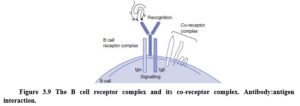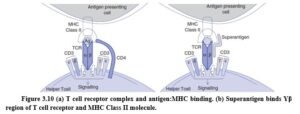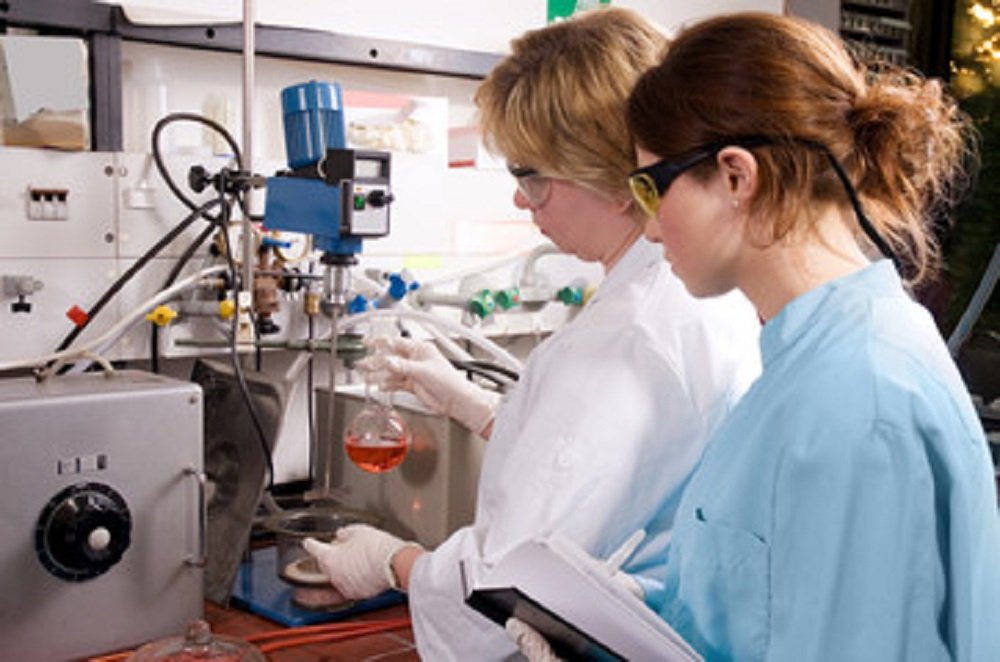In the adaptive immune response, lymphocytes have unique recognition structures that allow them to see antigen.
♦B cell receptor (BCR)
♦T cell receptor (TCR).
The BCR is surface bound immunoglobulin, and binds conformational epitopes. TCR binds linear epitopes, presented in grooves in MHC molecules. BCR, TCR and MHC proteins are all members of the immunoglobulin superfamily.
B cell receptor complex and B cell co-receptors The BCR complex comprises BCR surface immunoglobulin (sIg) associated with two signaling molecules Iga and IgP (Figure 3.9). Iga and IgP are also required for assembly and expression of sIg. When antigen cross-links sIg, Iga and IgP transduce activation signals into the B cell. Ligation of B cell co-receptors can enhance or inhibit signaling via the Ig-Iga/IgP complex. Optimal activation requires additional signals from helper T cells. Activated B cells differentiate into plasma cells and secrete antibody.

Antibody-antigen interactions The antigen-binding site of immunoglobulin molecules is composed of variable regions of both heavy and light chains. Antigen specificity of the immunoglobulin is determined by variation in the amino acid sequences of variable regions. Three segments are particularly variable – hypervariable (HV) regions 1-3. Hypervariable segments form surfaces complementary to the antigen: complementarity-determining regions (CDRs) 1-3. Variation in the amino acid sequences of CDRs creates different surface shapes. Antibodies bind epitopes with complementary shapes which fit tightly (Figure 3.9).
T cell receptor (TCR), the TCR complex and co-receptors Most T cells have antigen receptors composed of a and β chains, each with variable and constant regions (V and C regions). A subpopulation of T cells, the function of which is poorly understood, express TCRs consisting of y and δ chains. The TCR complex consists of the TCR associated with CD3 a signaling complex. CD4 or CD8 (co-receptors) play an important role in stabilising the interaction of TCR with MHC-peptide complex.
TCRs interact directly with both the antigenic peptide and some polymorphic regions of the MHC molecule presenting the peptide. CD4 or CD8 help to stabilise the TCR- peptide-MHC interaction which is of very low avidity. CD4 and CD8 distinguish two different functional sets of T cell. CD4 is expressed on helper T cells and binds a nonpolymorphic region of MHC Class II molecules. This effectively restricts helper T cells to recognise peptides appropriately presented on MHC Class II molecules. In contrast, CD8 is expressed on cytotoxic T cells allowing recognition of peptides presented on MHC Class I molecules which is widely expressed.
TCR-peptide-MHC interaction TCRs recognise antigenic peptides bound to MHC molecules on cell surfaces (Figure 3.10(a)). This crucial interaction determines the antigen specificity of adaptive immune responses. Proteins are unfolded, processed into peptide fragments by intracellular proteases, and small peptides are presented in the groove of MHC molecules. Endogenous antigens, and viral proteins, associate with MHC Class I molecules, found on all nucleated cells. Antigens including those derived from pathogens internalised by endocytosis from extracellular fluid, associate with MHC Class II molecules, found on specialised APCs.

Superantigen Classical antigens generate peptides that bind the peptide-binding groove of MHC Class II. In contrast superantigens bind directly to MHC without processing. Superantigens bind to relatively non-polymorphic portions of MHC Class II and the Vp region of the TCR (Figure 3.10b). Each superantigen can bind a few families of Vp gene segments, and therefore superantigens can stimulate 2- 20% of all T cells. This type of response causes a massive production of CD4 T cell cytokines resulting in systemic toxicity and suppression of adaptive immunity.
Clinically important superantigens include Staphylococcal enterotoxins that cause food poisoning, and the toxic shock syndrome toxin (TSST).




